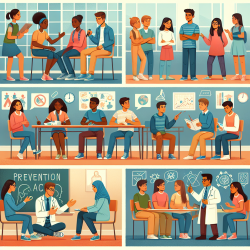Introduction
In the realm of adolescent development, the concept of school connectedness plays a pivotal role. This sense of belonging and attachment to the school environment has far-reaching implications for the well-being and behavioral outcomes of students. The research article titled "School Connectedness and Risk for Sexual Intercourse and Nonconsensual Sex in Adolescence" sheds light on how enhancing school connectedness can mitigate sexual risks among adolescents. This blog aims to guide practitioners in leveraging these insights to improve their practice and foster safer school environments.
Understanding School Connectedness
School connectedness is defined as the extent to which students feel cared for, valued, accepted, and supported by their peers and teachers. It functions within Bronfenbrenner’s microsystem of direct interaction, where these proximal interactions significantly impact individual development. Evidence suggests that perceived school connectedness not only promotes emotional well-being but also reduces risky behaviors, including sexual risk-taking activities.
Research Findings: Gender Differences
The study conducted by Miller, Gajos, and Cropsey (2023) highlights significant gender differences in the association between school connectedness and sexual practices. For girls, greater school connectedness was associated with a reduced risk of engaging in sexual intercourse. Conversely, for boys, school connectedness appeared to confer protection against nonconsensual sex. These findings underscore the importance of tailoring interventions to address gender-specific needs and challenges.
Implications for Practitioners
Practitioners can utilize these findings to develop targeted strategies that enhance school connectedness and mitigate sexual risks among adolescents. Here are some actionable steps:
- Foster Inclusive School Environments: Encourage inclusivity and a sense of belonging by promoting activities that engage all students, regardless of gender or background.
- Strengthen Student-Teacher Relationships: Cultivate supportive relationships between students and teachers, as these are critical in fostering a sense of connectedness.
- Implement Gender-Sensitive Programs: Design programs that address the unique needs of boys and girls, focusing on reducing risk factors specific to each gender.
- Promote Peer Support Networks: Encourage peer-led initiatives that foster supportive networks and positive peer influences.
Encouraging Further Research
While the current study provides valuable insights, further research is needed to explore the nuances of school connectedness and its impact on adolescent sexual behavior. Practitioners are encouraged to engage in ongoing research to refine interventions and develop evidence-based strategies that effectively address the diverse needs of adolescents.
Conclusion
School connectedness is a powerful tool in mitigating sexual risks among adolescents. By fostering environments where students feel valued and accepted, practitioners can play a crucial role in shaping positive developmental trajectories. The findings of this study offer a foundation for developing targeted interventions that promote safer and more supportive school environments.
To read the original research paper, please follow this link: School Connectedness and Risk for Sexual Intercourse and Nonconsensual Sex in Adolescence.










